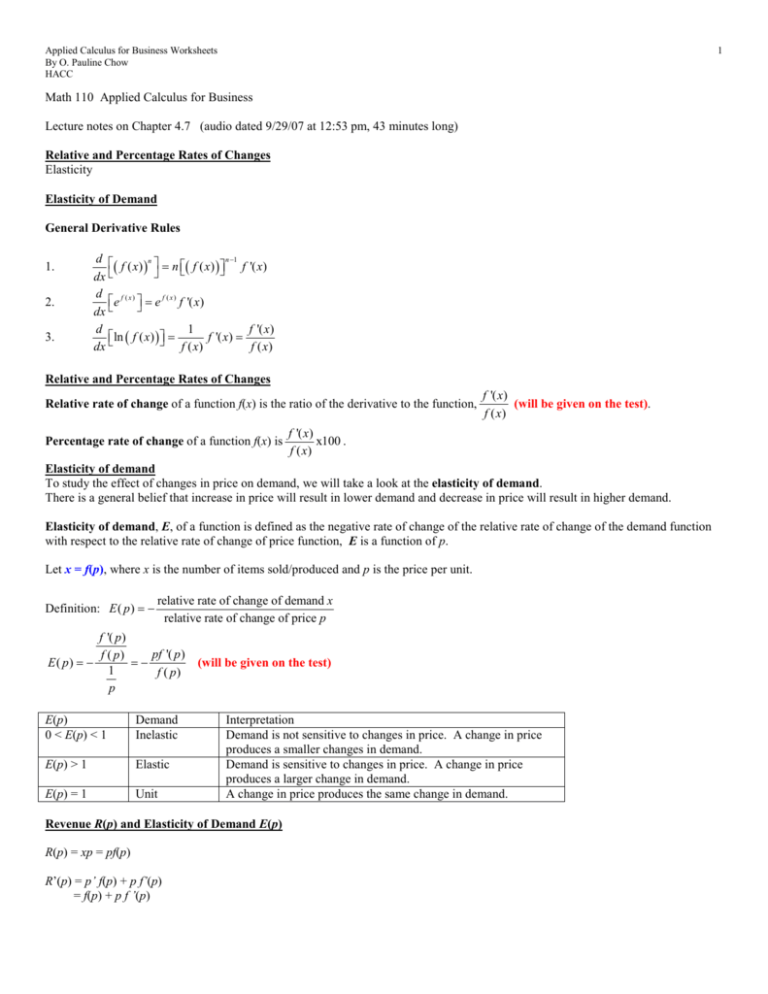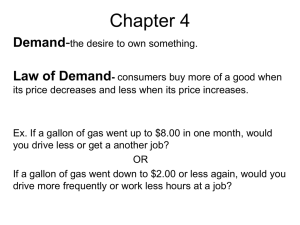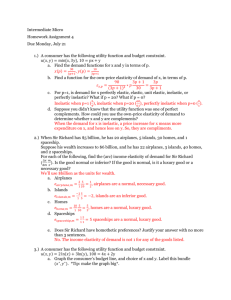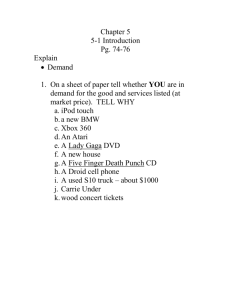Math 110 Applied Calculus for Business Lecture notes on
advertisement

Applied Calculus for Business Worksheets By O. Pauline Chow HACC 1 Math 110 Applied Calculus for Business Lecture notes on Chapter 4.7 (audio dated 9/29/07 at 12:53 pm, 43 minutes long) Relative and Percentage Rates of Changes Elasticity Elasticity of Demand General Derivative Rules 1. 2. 3. n −1 d n ( f ( x) ) = n ( f ( x) ) f '( x) dx d e f ( x ) = e f ( x ) f '( x) dx d 1 f '( x) ln ( f ( x) ) = f '( x) = dx f ( x) f ( x) Relative and Percentage Rates of Changes Relative rate of change of a function f(x) is the ratio of the derivative to the function, Percentage rate of change of a function f(x) is f '( x) (will be given on the test). f ( x) f '( x) x100 . f ( x) Elasticity of demand To study the effect of changes in price on demand, we will take a look at the elasticity of demand. There is a general belief that increase in price will result in lower demand and decrease in price will result in higher demand. Elasticity of demand, E, of a function is defined as the negative rate of change of the relative rate of change of the demand function with respect to the relative rate of change of price function, E is a function of p. Let x = f(p), where x is the number of items sold/produced and p is the price per unit. Definition: E ( p ) = − relative rate of change of demand x relative rate of change of price p f '( p) pf '( p ) f ( p) E ( p) = − =− 1 f ( p) p E(p) 0 < E(p) < 1 Demand Inelastic E(p) > 1 Elastic E(p) = 1 Unit (will be given on the test) Interpretation Demand is not sensitive to changes in price. A change in price produces a smaller changes in demand. Demand is sensitive to changes in price. A change in price produces a larger change in demand. A change in price produces the same change in demand. Revenue R(p) and Elasticity of Demand E(p) R(p) = xp = pf(p) R’(p) = p’ f(p) + p f’(p) = f(p) + p f ’(p) Applied Calculus for Business Worksheets By O. Pauline Chow HACC pf '( p ) = f ( p ) 1 + f ( p ) R’(p) = f(p) [1 – E(p)] (will be given on the test) Demand is inelastic if R’(p) > 0 and E(p) < 1. As price increases, revenue increases and vice versa. Demand is elastic if R’(p) < 0 and E(p) > 1. As price increases, revenue decreases and vice versa. You have to know above relationship on the test. Find the relative rate of change of f(x). Ex 1: f(x) = 50x – 0.01x2 f '( x) 50 − 0.02 x = f ( x) 50 x − 0.01x 2 Ex 2: f(x) = 15x + 2x ln x 1 15 + 2 ln x + 2 x f '( x) 17 + 2 ln x x = = f ( x) 15 x + 2 x ln x 15 x + 2 x ln x Ex 3: Given: x = f(p) = 875 – p – 0.05p2. Find E(50), E(70), E(100). Comment elasticity. f ’(p) = –1 – 0.10p p [ −1 − 0.10 p ] pf '( p ) p + 0.10 p 2 E(p) = − =− = 2 f ( p) 875 − p − 0.05 p 875 − p − 0.05 p 2 E(50) = = (50) + 0.10(50) 2 300 3 = = < 1 , demand is inelastic. 875 − (50) − 0.05(50) 2 700 7 E(70) = = (70) + 0.10(70) 2 560 = = 1 , demand is unit. 875 − (70) − 0.05(70) 2 560 E(100) = (100) + 0.10(100)2 1100 = = 4 > 1 , demand is elastic. 2 275 875 − (100) − 0.05(100) Ex 4: Given: x = f(p) = 10(p – 9)2 . Find the values of p for which the demand is elastic and the values for which the demand is inelastic. First you need to find E(p). f ’(p) = 20(p – 9) E ( p) = − −2 p pf '( p) 20 p[ p − 9] =− = f ( p) 10( p − 9)2 ( p − 9) Next you need to find the values of p when the demand is elastic. E ( p) > 1 demand is elastic −2 p >1 p −9 −2 p −1 > 0 p −9 2 Applied Calculus for Business Worksheets By O. Pauline Chow HACC −2 p p − 9 − >0 p −9 p −9 −2 p − p + 9 >0 p−9 −3 p + 9 >0 p −9 Now use the sign graph of −3 p + 9 to solve the inequality. p −9 p – 9 = 0, p = 9 –3p + 9 = 0, p = 3 __– – – |_+ + +|_– – – _ 3 9 So, if E(p) > 1, 3 < p < 9. Demand is elastic when 3 < p < 9. Revenue is decreasing when price increases. If 0 < E(p) < 1, the demand is inelastic when 0 < p < 3 and revenue is increasing when price increases. Note: For graphing calculator user: you may use the TI to solve the inequality: E ( p) > 1 −2 p >1 p −9 demand is elastic Enter y1 = –2x/(x – 9) and y2 = 1 Since −2 p > 1 means the graph of y1 = –2x/(x – 9) is greater than y2 = 1, x is between 3 and 9. See the graph below: p −9 Ex 5: Given: x = f ( p) = 30 − 5 p . Find the values of p for which the demand is elastic and the values for which the demand is inelastic. First you need to find E(p). 5 1 f '( p ) = −5 p −1/ 2 = − 2 p 2 3 Applied Calculus for Business Worksheets By O. Pauline Chow HACC E ( p) = − 4 5 p − 2 p 5 p p pf '( p ) =− = = f ( p) 30 − 5 p 2(30 − 5 p ) 2(6 − p ) Next you need to find the values of p when the demand is elastic. E ( p) > 1 demand is elastic p >1 2(6 − p ) p 2(6 − p ) p 2(6 − p ) −1 > 0 − 2(6 − p ) 2(6 − p ) p − 12 + 2 p 2(6 − p ) 3 p − 12 2(6 − p ) 3( p − 4) 2(6 − p ) >0 >0 >0 >0 Now use the sign graph of 3( p − 4) 2(6 − p ) to solve the inequality. p −4 = 0 p =4 p = 16 6− p 6= p p = 36 _–_– – |_+ + +|_– – – _ 16 36 So, if E(p) > 1, 16 < p <36. Demand is elastic when 16 < p < 36. Revenue is decreasing when the price increases. So, if 0 < E(p) < 1, 0 < p < 16. Demand is inelastic. Revenue is increasing when the price increases. TI user: E ( p) > 1 p 2(6 − p ) demand is elastic >1 Enter y1 = x1/2/(12 – 2p1/2) and y2 = 1 Applied Calculus for Business Worksheets By O. Pauline Chow HACC 5 So, demand is elastic when 16 < p < 36 and inelastic when 0 < p < 16. Ex 6: The fast food restaurant can produce an order of fries for $0.40. If the restaurant’s daily sales are increasing at the rate of 15 per day, how fast is their daily cost for fries increasing? cost per order of fries = 0.40 and rate of change of demand is 15 per day The daily cost is cost per order of fries times the demand per day = 0.40(15) = $6 per day Ex 7: The price-demand equation for hamburgers at a fast food restaurant is x + 400p = 2000. Currently, the price of a hamburger is $3.00, will a 10% price increase cause the revenue to increase or decrease? [Hint: Find E(p)] x = 2000 – 400p E ( p) = − pf '( p) p[−400] 400 p p =− = = f ( p) 2000 − 400 p 400(5 − p ) 5 − p p = 3, E (3) = 3 = 1.5 > 1 5−3 If E(3) > 1, then demand is elastic. R’(p) = f(p)[1 – E(p)] < 0; R decreases So, 10% price increase will cause a decrease in revenue.









